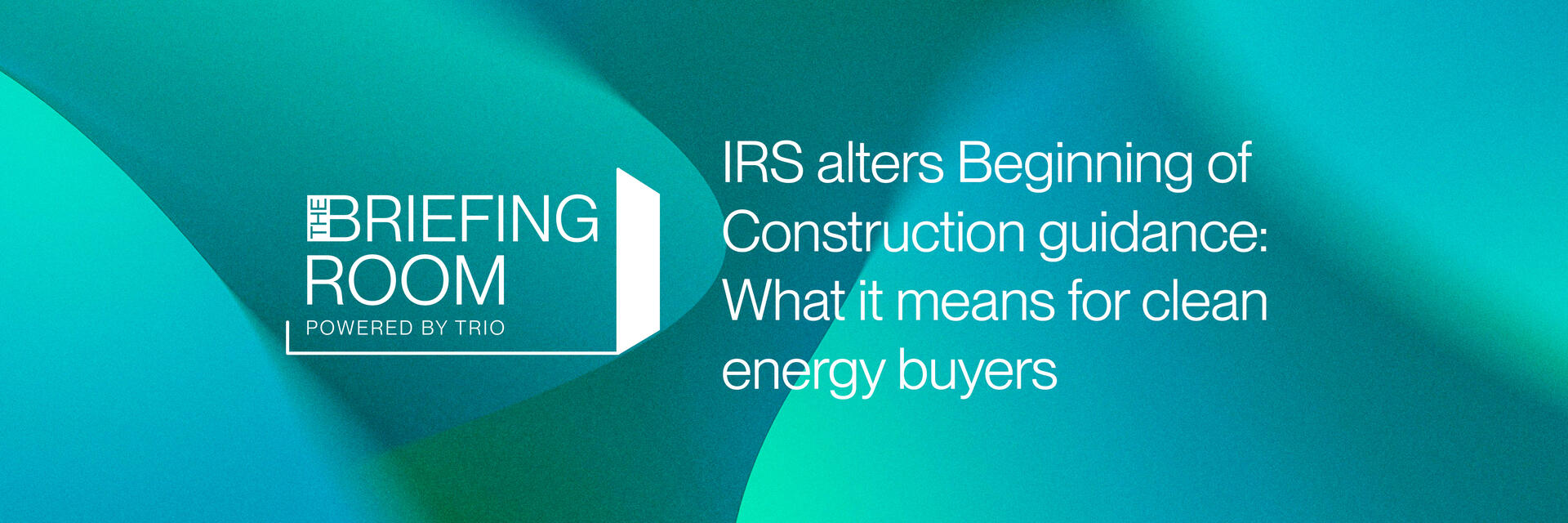The Briefing Room: IRS alters Beginning of Construction guidance: What it means for clean energy buyers

By Matt Donath, Policy Manager
On August 15, 2025, the IRS and Treasury released Notice 2025-42, issuing new guidance on how renewable energy developers can establish the beginning of construction (BoC) for wind and solar projects seeking the Clean Electricity Production Tax Credit (45Y PTC) and the Clean Electricity Investment Tax Credit (48E ITC).
The IRS issued the new guidance in response to Executive Order 14315, signed by President Donald Trump on July 7. This order directed Treasury to revisit the previously established beginning of construction rules following the enactment of the One Big Beautiful Bill Act (OBBBA).
The OBBBA phases out the PTC and ITC early and establishes new foreign entity of concern (FEOC) rules, both of which impact projects based on when they begin construction, making the new guidance critically important. Under OBBBA, projects that reach the beginning of construction after July 4, 2026, must be placed in service by December 31, 2027, to receive tax credits. Projects that reach beginning of construction after December 31, 2025, would be subject to the new FEOC restrictions.
Background: How Beginning of Construction has worked
Since 2013, IRS guidance on beginning of construction has generally provided developers with two paths to qualify a project:
- The Physical Work Test: construction begins once significant physical work has started, either onsite or through offsite manufacturing of custom components.
- The Five Percent Safe Harbor: projects qualify for BoC if the developer incurred at least 5% of total project costs before the statutory deadline.
Together, these pathways gave developers flexibility and certainty that projects could secure tax credit eligibility even when faced with permitting delays, financing hurdles, or supply chain issues. In addition, a “continuity requirement” ensured that projects moved forward after establishing BoC, but a safe harbor allowed projects placed in service within four years to automatically satisfy this test.
What new Treasury guidance changes
The new guidance significantly narrows the ways developers can demonstrate beginning of construction. The Five Percent Safe Harbor only remains available for low-capacity solar facilities of 1.5 megawatts (MW) or less and will no longer be available for utility-scale projects. For such projects, the Physical Work Test will now be the sole method for securing BoC.
The Physical Work Test must show facts and circumstances that show the taxpayer has commenced physical work of a significant nature, not tied to a specific amount of work or monetary value. Importantly, the new rules still allow for both onsite and offsite work to satisfy this requirement if performed by the taxpayers or under a written agreement with a third party but excludes components that are held in inventory.
The IRS also reaffirmed that the continuity requirement remains in place, with the four-year continuity safe harbor preserved. This means that once physical work has begun, projects remain eligible if they are placed in service within four calendar years or show continuous construction activity. If the four-year window is exceeded, whether a continuous construction satisfies eligibility requirement will be determined on relevant facts and circumstances.
The rules maintain the list of eligible construction delays that can disrupt work without violating the continuity requirements, but otherwise projects must demonstrate continuous construction with physical work of significant nature.
Reaction from the industry
Following the release of IRS Notice 2025‑42, clean energy stocks leapt ahead, signaling investor relief that the guidance was less punitive than expected. Shares of major solar players rose, with increases ranging from approximately 5% to 9%, reflecting market confidence that while the five percent safe harbor was scaled back, continuity measures and fair access remained intact.
Across the industry, sentiment is cautiously optimistic. Many see the four-year continuity safe harbor as a “better than worst‑case scenario,” offering a manageable path forward. Yet most developers remain intensely focused on securing their near-term pipeline without venturing too far into longer-term strategic planning to ensure projects can capture tax credits in line with changes enacted through OBBBA.
Developers anticipate rising engineering, procurement, and construction (EPC) pricing as projects rush to begin physical work before the July 2026 deadline to avoid the December 2027 placed in service deadline. While this spike may not immediately translate into higher PPA prices, its ripple effects are expected to materialize over time.
Developers in the distributed generation and community solar space are adapting in light of OBBBA and the new BoC guidance. Some are pivoting to M&A activity, targeting projects that are already well advanced, while deprioritizing new onsite development absent ideal conditions (e.g., large-scale offtake, markets with clear development and construction paths). They’re leveraging safe‑harbored modules to support acquisitions of projects nearer to completion that can benefit from an injection of capital to meet tax credit deadlines.
What it means for buyers
For corporate clean energy buyers, the IRS guidance underscores both the urgency and the opportunity in the current market. While the elimination of the Five Percent Safe Harbor removes a familiar tool, the preservation of the Physical Work Test and the four-year continuity safe harbor means there is still a clear and workable path to secure eligibility for tax credits.
What has changed is the timeline. Under the OBBBA framework, projects must now begin construction by July 2026 to qualify for the ITC or PTC, and the IRS has reinforced that beginning of construction will require tangible physical work. This compressed schedule will put pressure on developers to advance projects quickly, and buyers should anticipate ripple effects on project availability, EPC pricing, and contracting timelines.
For buyers, the key takeaway is that procurement opportunities are available but securing them will require earlier engagement and faster decision-making. Acting now to align procurement strategies with developers’ accelerated timelines will be essential. Those who move proactively will be best positioned to lock in projects that deliver both clean energy attributes and the full benefit of available tax credits.
